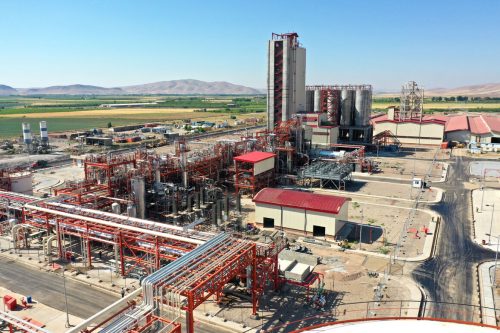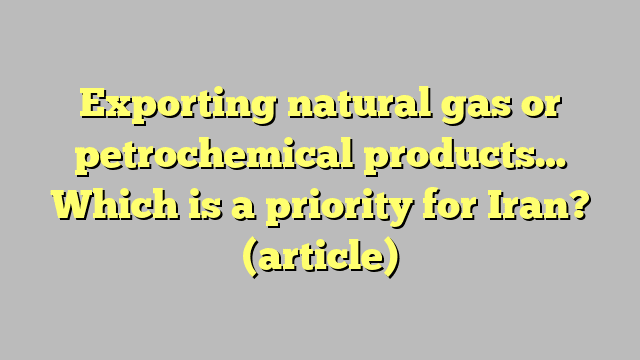Read in this article
- • Iran consumes most of the natural gas inside the country in the sectors of fuel, raw materials and injection
- • Iran exports 70% of the final products of the petrochemical industry and consumes 30% locally
- • The competition between methanol and LPG will depend on the price of oil in the future
- • The advantage of the Iranian petrochemical industry in converting value-added products is very high
- • The Iranian petrochemical industry cannot compete with Saudi Arabia without advanced technology and financial resources
The natural gas value chain is very diverse and can primarily be categorized into 4 sectors: fuels, feedstocks, exports and injections.
Because of its adoption of a policy of replacing liquid fuels with natural gas, Iran consumes most of the gas inside the country in the fuel, feed and injection sectors, and the export share of Iranian gas production is very low.
Besides a stable supply of fuel, natural gas in Iran’s petrochemical industry is the feedstock for the production of urea and methanol products.
Petrochemical industry
After the opening of petrochemical complexes in 2020, about 7.4% of Iran’s natural gas consumption (equivalent to about 44 million cubic meters per day) is spent on annual production of 7.6 million tons of urea and 10.6 million tons of methanol.
The nominal production capacity of urea and methanol will reach 13 and 27 million tons per year, respectively, by 2025.
Although Iranian methanol complexes consumed 28 million cubic meters of gas per day in 2021, they will consume about 80 million cubic meters of natural gas per day in 2025 with the exploitation of new methanol projects.

On the other hand, the establishment of petrochemical complexes requires the availability of 3 necessary elements: gas or feedstock (if petrochemicals with a subsequent product), water and a suitable place to transport or export the product.
In light of these factors, most of Iran’s petrochemical units are located in the south of Iran, where 70% of the final products of the petrochemical industry are exported, and 30% is consumed domestically. Most of the exports go to China.
It should be borne in mind that there are currently 9 active methanol projects and 11 projects under implementation in Iran, and 8 urea production units are available.
Urea production this year is based on a nominal capacity of 8,692 tons, and at the same time, methanol production is 14 times the domestic consumption under current conditions.
Value chain in the petrochemical industry
According to the head of the National Iranian Petrochemical Company (NBC), Morteza Shahmirzaei, a document on the value chain in the petrochemical industry is being prepared.
With a forward-looking approach, Shahmirzai called on the National Petrochemical Company to “review development plans with a focus on completing the value chain.”
He continued, saying: The development of the petrochemical industry’s plans in the coming years depends on the logic of making the most of the available feedstocks in the oil and gas industry and the flexibility of the domestic and foreign markets. There are – currently – 68 projects in the petrochemical industry that will go into production in the next 5 years.
petrochemical contribution from natural gas, ethane, propane, butane, condensate, and naphtha; As the main feedstock for petrochemical complexes, it is large and increasing annually.
The ideal foreseen by the petrochemical industry for its balanced and sustainable development is access to all types of liquid and gaseous feedstocks.
Despite the rich oil and gas resources in the country, it is better to sell a large part of the gas produced in the industrial sector rather than selling it as a raw product or flaring it.
At the local level, this share in the petrochemical industry will become an added value.
methanol export
One of the important uses of methanol in China – Iran’s main export destination – is as a fuel for cars, home stoves, and industrial boilers.
The competition between methanol and LPG will depend on the price of oil in the future, but in the case of LNG, other factors are also at play.
Some energy experts in Iran believe that in the event of a stable supply of natural gas from underground sources in the long term, various export routes can be pursued, including through the petrochemical industries.
Moreover, the conversion of natural gas into petrochemical products and their export is one of the branches of the natural gas value chain, which has been well followed over the past decade in Iran, and must be completed through the development of downstream industries.
Since the demand for methanol and urea end products in the country is much lower than the current and future production of the petrochemical industry, it is absolutely necessary to study and forecast the global markets for the export of these materials.
In recent years, with the sanctions still in place, there has been much discussion about handing over stocks of cheap feedstock to petrochemical facilities in Iran.
Therefore, it must be taken into account that the exploration and production sector in the Iranian petrochemical industry – which has an annual income of $20 billion, of which about 70% of export income – is one of the most active industries in Iran.
Feed materials

Because Iran is self-sufficient in providing feedstock for petrochemical units, given its possession of huge oil and gas resources, the formula for determining the feed rate for the extraction and production sector in the petrochemical industry has always been discussed and reviewed by economists and petrochemical activists.
On the other hand, economists – who look at the billions in profitability of the petrochemical sector in extraction and production – say that part of this profit is due to cheap feedstock. These experts state that by determining the appropriate rates for feeding petrochemical units, profits can be maintained at the desired point, and billions in rents for the operators of this industry can be reduced for the benefit of the country’s economy.
Some calculations show that looking at the costs of constructing a pipeline to export gas or building petrochemical units and comparing in the past 10 years, for every cubic meter of gas consumed, the income from exporting urea increases by 8%.
Income from exporting methanol was 24% lower than direct exporting natural gas. It should be noted that the diversification of Iranian petrochemical products exports is very low, especially in the field of low-value products.
Urea, ammonia and methanol are the main Iranian export products, which are bulky products with low value and simple technology, and even their market share in neighboring countries is decreasing.
It also exports products such as detergents, but these are of low value and of low quality.
The advantage of the Iranian petrochemical industry in converting value-added products is very high. This policy has been on the agenda of governments for some time. Iran preferred to convert gas into petrochemical products in the petrochemical industries.
Although exporting gas has great value, exporting LNG means exporting products without added value.
However, if Iran converts natural gas into petrochemical products in petrochemical units, added value will be created, which is more beneficial from an economic point of view for the country.
Given the continuation of sanctions and the halting of nuclear talks, the Iranian petrochemical industry cannot compete with Saudi Arabia without the advanced technology and financial resources of foreign companies.
Iran will be able to increase urea production by delivering cheap feedstock to petrochemical units, as it can export products such as urea instead of natural gas (which is not feasible for Iran, as it faces a natural gas crisis).
Because of its uneconomical nature and the presence of many methanol production units in Iran, no new methanol units should be built, although some methanol units are under construction.
In the event that new sanctions are applied to the Iranian petrochemical industry, the conditions for exporting Iranian petrochemical products will become more difficult.
Iran must produce a variety of petrochemical products with high economic value by signing the nuclear agreement and attracting the necessary financial resources and advanced technology.
In the current situation, Iran cannot compete with Saudi Arabia in the regional market for petrochemical products.
* Dr. Omod Shoukry, senior advisor on foreign policy and energy geopolitics, is the author of “US Energy Diplomacy in the Caspian Basin: Changing Trends Since 2001.”
*This article represents the opinion of the author, and does not necessarily reflect the opinion of the energy platform.
related topics..
Also read..

Leave a Reply